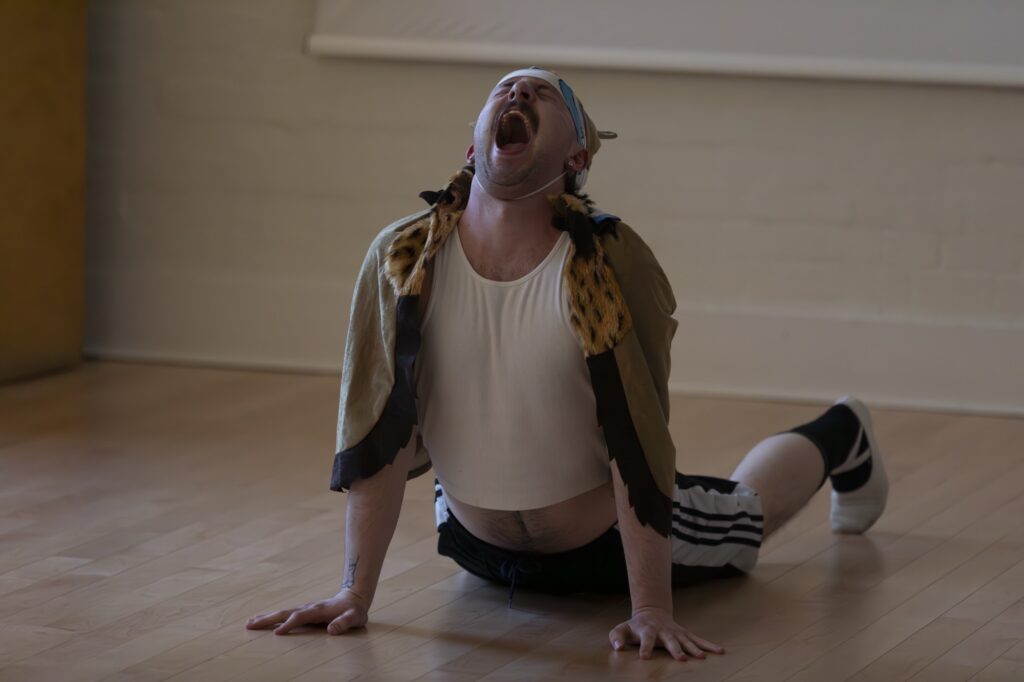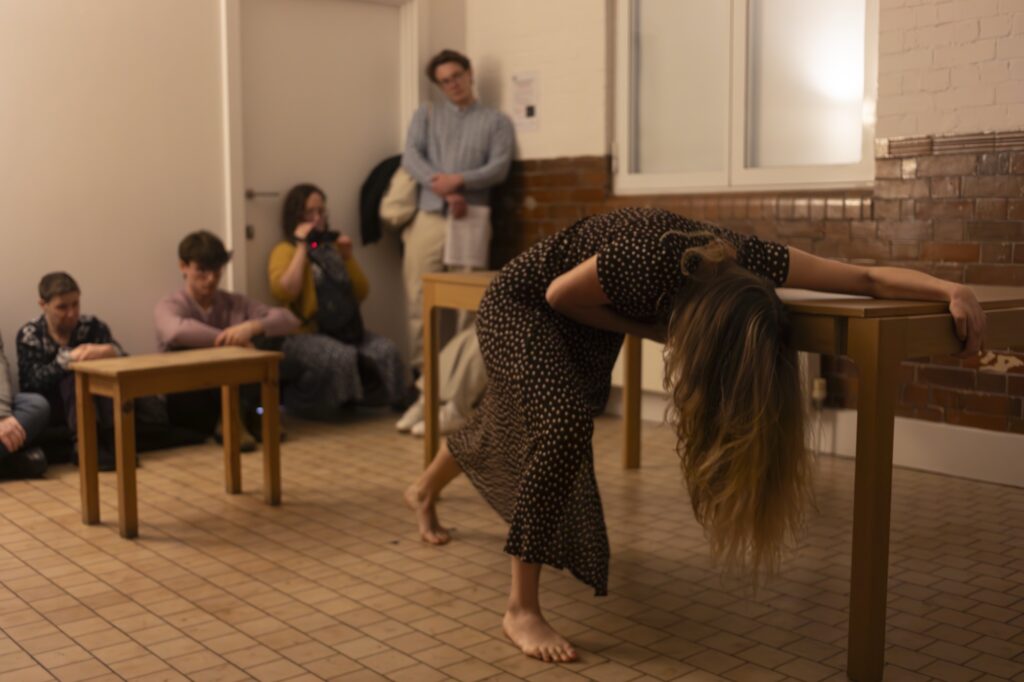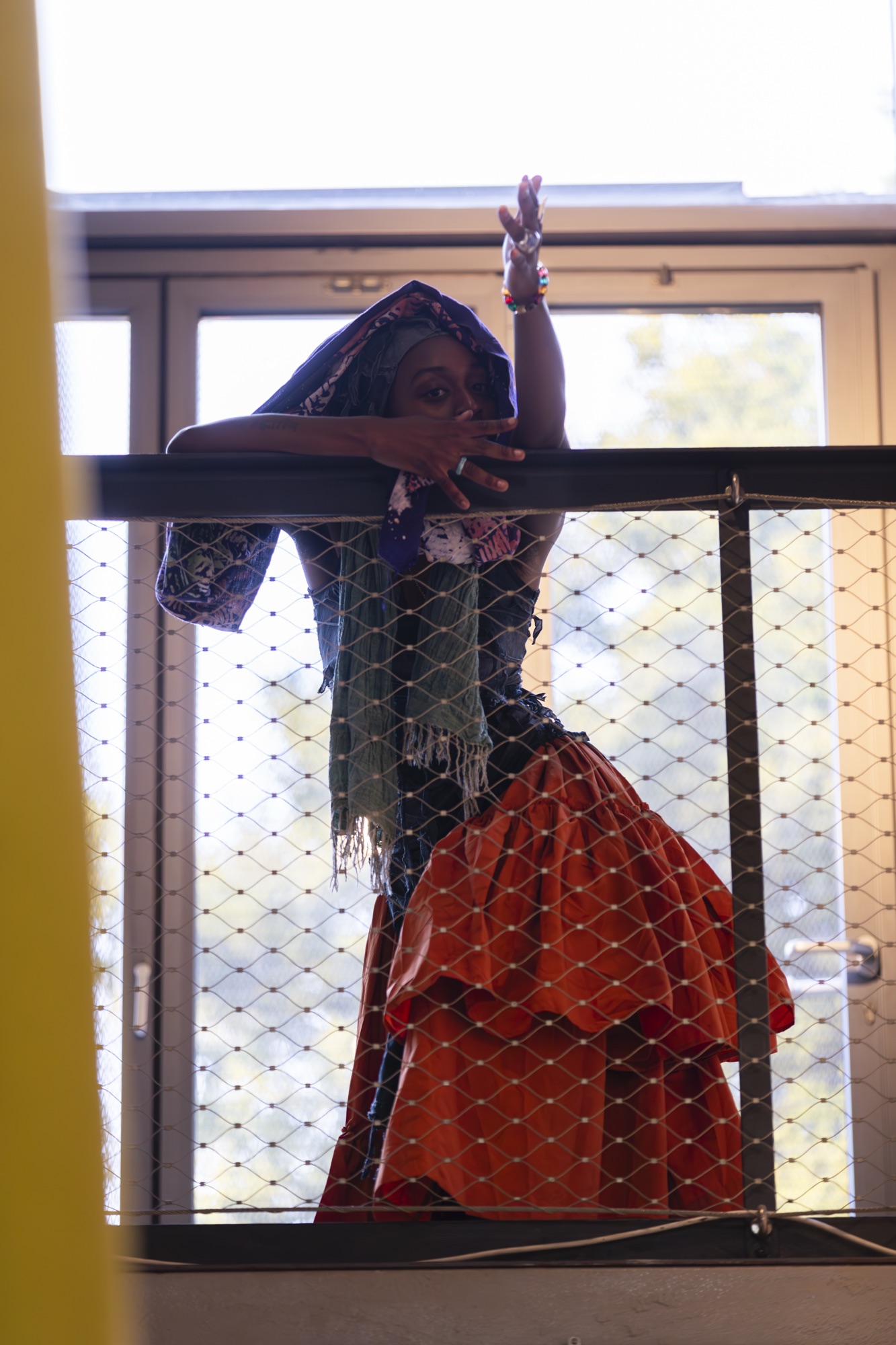Words by Stephanie Burrell.
At this year’s NEXT 2025 gathering at Siobhan Davies Studios, I witnessed a myriad of eclectic performances by a variety of different practitioners who had completed NEXT Choreography, a programme for young people looking for a route into choreography.
Two performances in particular—A Lament for Indengo by Aisha Odera and Argo by Sam Smith—explored questions of time, memory and embodied knowledge. Though distinct in tone and form, both works centred on memory’s cyclical nature, the multiplicity of voice and the co-creative role of the audience.
My experience as a spectator-participant unfolded both sensorially and poetically, where witnessing became a form of embodiment, and remembering, a practice of return. In this reflection, I explore these works and frame them in relation to their peers: Sofiia Nikiforova’s It is Spring but it’s the Plague (Urban Folklore) and Anna Longa’s Untitled.
Aisha Odera’s A Lament for Indengo is an on-going provocation to embody temporality. The line “whose forgotten footsteps are my free ones predicated upon?” stirred a temporal agitation within me as a reader of their artist notes. As spectator-participant in their dance, vocal, textile and sound performance on the balcony of Siobhan Davies Studios, it was an embodied invitation to attune to my own vitality, temporality and spirituality.
Since the gathering, Odera’s performance has reverberated and proliferated in my own personal and temporal archive; living memory, digital memory, fragments of notes. Bursts of words and my immediate cursive response are now stored and inscribed next to printed programme manuscripts, hinting to the importance of ancestral reverie and memory in the work.
Just like the performance itself, the way in which I remember and revisit the work is charged with recurrent yet periodic energy, where the past and present binary melt away through body, sound and material archive. My own digital archive of Odera’s duet with the balcony of the mezzanine floor exists as a time-loop in short bursts. The artist melted off the balcony with their arms stretched out addressing the ground floor like a Rhapsode. Yet the weight of their pelvis giving into gravity meant there was a pull downward from the chest, through the spine and into the hips and then the knees. Odera created syncopated rhythms in the vertical body and skeletal alignment where hinging and hanging met with endless knots and infinity loops in the hips.
Referring back to this ephemeral loop, that I have preserved in my digital ether, it grounds me back to the temporal and spatial moment I shared with the artist and other spectators at NEXT 2025. The endless digital replay continues to allows me to re-enter that space, re-receiving Odera’s libations. Their main vocal repetition, “I pour libations (for all lost and for all I move for),” echoes in my memory.
Memory is poured from the digital, cerebral and embodied realms. As I write, I recall their soft chants and meditative movement motifs, especially the tenderness with which their head and wrist met. To me, the essence of their piece is ceremony: both staged and physical, but also a cyclical life force. It offers homage to ancestry and your own life at any moment and through any medium—an overflow through temporality.
As A Lament for Indengo went on, through the performer’s gaze, a pouring and looping of considered temporality unfolded. Odera moved with an introspective, self-soothing gaze—writhe, roll, kneel—drawing spectators into an oneiric state. Their interiority became contagious. What began as observation slips into absorption.

Cerebral echoes, sensory activation and renewed embodiment came together as a triptych to further deepen my access to the performances throughout the NEXT 2025 evening. Tracing these ritual-like movements with my own body, my form became a vessel for substitution. Activating the digital traces through my own dance and body, Odera’s choreography acted as a framework to dive into the overlapping network of performance that gave life to Siobhan Davies Studios. Each undulation of my sternum and exploration of my pelvis invited me to reactivate my understanding and memory of Anna Longa’s piece Untitled.
The performers, draped in brown veils under the warm orange light of the roof studio, sat in a row one behind the other and shaped the space around them with their arms like a mass conjuring. To comment on this performance is to substitute myself into the piece itself. The performers’ brown translucent veils that skimmed the surface act as a sensory metaphor for re-remembering the performance through cerebral visualisation. Sketches and ephemera swirl, float and undulate underneath the veil that are made concrete and activated through writing and embodiment.
A flow continuum pulses through spine, torso and hips, accompanied by sonic pourings that charged the piece with transcendental potential. Witnessing the performance in close proximity initiates a feedback loop between movement and memory. “The exponential growth of a simple positive loop is inherently unstable, quickly summing toward impossible infinities.” This loop became a portal—an open channel for energy, affect and shared experience offered out by Odera.
The initial co-participation returned through recollection, whether sparked by digital documentation or cerebral memory. The body remembers, and in doing so, reactivates the piece. The chant— “I pour libations (for all lost and for all I move for)”—echoed as a ritual of return, a collective memory etched in both body and mind. This is not a work that ends; it transforms and continues to transform those who encounter it.
Odera’s libations, and the pouring of them, was a portal to their artistry beyond their own portfolio. This transformation enabled the viewer to then experience Anna Longa’s Untitled through a new lens of simultaneity, cross-pollination and collaboration. Odera’s appearance in Untitled was a physical manifestation of the porousness of their artistic universe. Their presence and affect seamlessly looped throughout the building and legacy of NEXT 2025. Collective memory through ceremony was present in Longa’s work where the artist literally poured water from vases. Paying reverence was a theme that bound artists together in vital cross-collaboration where the act of pouring was conceptual and material. Untitled and A Lament for Indengo are universes where ceremony, transcendence and bodily re-activation unite.

Stepping through thresholds of sound, movement and memory, A Lament for Indengo offered libation as lament. Argo by Sam Smith by contrast, poured language into a looping score — where each verbatim retelling became a thread of reverence, revision and re-embodiment. Both works insisted that memory lives not in fixity, but in flow.
Smith shaped the research studio into proscenium arch staging, and entered with gentle force to bestow their praxis manifesto as a custodian of memory. They laid out a huge scroll of paper horizontally across the space, inviting in the audience to document their thoughts and reflections throughout the durational performance. The proscenium arch dissolved as Smith offered an invitation to venture beyond and reach into the performance with real-time co-reflexion. This softening enabled a freer flow of thought and more inclusive modes of viewing, heralding a practice where the viewer-participant enters, exists, and self-regulates their embodied engagement as they please.
Smith’s staging fostered multiple points of access—physical, emotional, conceptual—each plural and gentle in its offering. Argo emerged as a porous encounter, where community ebbed and flowed as a backdrop to verbatim audio recounting the experiences of trans dancers within the British contemporary dance context.
Threshold and anti-flow punctuated Sofiia Nikiforova’s work in contrast. It is Spring but it’s the Plague (Urban Folklore) is an encased spiralling of tension, force, sensuality, femininity and effort. A vacuum where grimace, gesticulation and homage to Pina Bausch and operatic vocals on a wooden table dominated the performer’s discourse. The audience decorated the four walls of the empty library. Voyeurs to a seduction that malfunctioned where plaiting of hair meets effortful moves akin to repetitive efforts of physical labour. A powerful and punctuated performance that rejected flow and temporal looping, we witnessed a mutating or spiralling sense of mood and character.
Although Smith’s and Nikiforova’s works stand in antithesis with one another vis a vis encounter and access, both make stark commentaries on gender and labour. Smith’s commentaries are danced through the current and contemporary British political context. A poignant moment was when Smith performed an act of ‘Bad Ballet’ against a Michael Clark Company poster on a projector, layered with audio on the commercialised spectacle of the gay cis-man dancing in pointe shoes versus the ever-prominent marginalisation of the transfemme body. Smith’s subtly sickled ankle in tendu from fifth, a rotating “boreé” where the ankles resisted the perfect fifth position on demi-pointe, and the length and elongation of their arms in fifth were met with slight contraction. These body augmentations, through problematising the physical practice of ballet, literally opened up windows and framings for reflection through Smith’s talocrural joint mobilisations. A literal entry point into safe discursive reflection on the state of UK dance through a queer lens.
The openings of the body echoed a broader ethic: resisting top-down practices, fostering an open-door policy and centring verbatim testimony. One interviewee, empowered to invent new language, coined the term “jesterisation”—a lexical intervention in naming how queer dance is commodified rather than standardised. Through this, Smith wove together spatial, sonic and embodied threads of affect: where top-down, prescriptive methodologies were replaced by plural offerings for both viewer and performer. In doing so, Smith left room for autonomous engagement and emergent reflections. In Argo, witnessing and contributing were not oppositional acts—they blurred into one another.
To witness the works at NEXT 2025 was to enter a porous choreographic encounter—where memory is not fixed but fluid, continuously reactivated across body, sound, and digital trace. These works do not conclude; they echo, inviting return…
Each artist, in their own distinct way, challenged how we hold memory in the body—and how choreography can move through us long after the performance ends.
